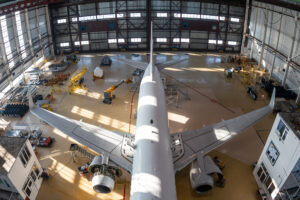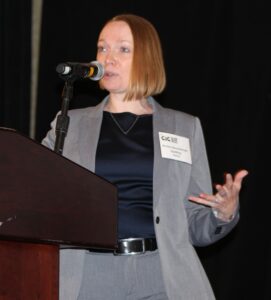
Aviation and collision repair: Boeing speaker shares similarities, importance of OEM procedures
By onBusiness Practices | Collision Repair | Repair Operations
A special presentation during the April Collision Industry Conference (CIC) meeting Wednesday in Seattle drew parallels between another sector of transportation and the collision repair industry following a recent Boeing in-flight mishap in January.
Kirsten Bossenbroek Spalding, Boeing liaison engineering composite repair team lead, shared information about the steps and regulatory bodies that airline OEMs follow and lay out for operators and Maintenance Repair and Overhaul (MRO) facilities, including repair procedures.
“We [liaisons] are an engineering function but we’re the go-between,” she said. “We sit on the shop floor next to the airplane and we are the connection between operations, manufacturing, and quality personnel and the rest of the engineering departments within the company… We touch absolutely everything on the aircraft.”
Bossenbroek Spalding is also part of a volunteer aviation organization called the Commercial Aircraft Composite Repair Committee (CACRC).
“You could just swap out the word automotive for aircraft and it sounds like we’re having very similar conversations,” she said.
The presentation to the CIC body focused on those industry efforts to identify opportunities and document processes and solutions.
CACRC works to promote repair standardization to increase safety while also reducing costs and publishing a number of repair standards, she added.
Just like with vehicles, aircraft finishes need to be within a very narrow band of thickness or there will be issues with functionality.
“Someone might guess, ‘Oh, well you just need it to look good.’ OK, but it’s also performing environmental protection on that part,” Bossenbroek Spalding said. “We’re protecting any of the substrate from UV degradation and erosion. It also needs to be smooth [to meet] aerodynamic requirements.
“If someone maybe only knows that one piece of it or is making that assumption they might then say, ‘Oh, well if it’s there for UV protection and erosion and environmental protection, then more is better, right?’ …Finishes that are too thick can lead to other issues. It can lead to mud cracking and then not holding up over time, but then also you don’t necessarily know if that part is going over some piece of equipment where there’s a sensor behind there.”
That’s a common issue collision repairers also face — knowing where sensors and cameras for advanced driver assistance systems (ADAS) are located and how refinish near and around them should be performed for proper future function.
“Without fully understanding the engineering intent of all those pieces and parts, it’s tempting to maybe shortcut the process,” Bossenbroek Spalding said, referring to aircraft repairs. “They may not want to follow so many dozens or hundreds of steps in a repair process coming from the OEM. That’s also something that we are aware of in our processes.”
CACRC works to detail the “why” behind repair procedures to help repairers understand the importance of following them.
Other issues facing the aviation industry that CACRC is working to address range from wasted materials and high maintenance costs to preferred materials not being SAE-qualified, she said.
The group has eight task force groups:
-
- Repair Materials — identify common materials that every OEM would use
- Repair Procedures — overall steps to repair
- Repair Analysis — what will be supported and endorsed
- Repair Techniques — materials, application, specific pieces and parts of the procedures; a lot of haggling between OEMs on what’s accepted
- Modifications — created after the pandemic because composite use and modification to airplanes were becoming more common
- Training — industry baseline training standards for trainers
- Inspection — development of training materials and guidance
- Design — OEMs and others provide feedback on designs and create case studies for best practices moving forward
The CACRC Repair Materials Task Force works with material suppliers to identify common repair materials that every OEM could start supporting and including in their structural repair manuals to establish industry-standard allowable and qualification data, Bossenbroek Spalding said.
She added, “Why would an OEM go through this trouble of creating all this additional substantiation data for having an industry-standard repair material [when] it’s easy or more cost-effective for them to just keep using their proprietary base material that they have on the part already?”
The reason is to ensure OEM customers are happy with their products and can maintain them, according to Bossenbroek Spalding.
Staying up to date with the latest repair processes can be a challenge for smaller or newer airlines compared to larger, more established ones, which is another issue CACRC hopes to mitigate through its Training Task Group. The group works in partnership with regulatory agencies to publish additional guidance material for the industry.
“We put out a number of different course curriculums for basic composite damage inspection — what it’s going to look like, when you’re going to need additional instrumented ultrasonic inspection, what exactly that’s going to tell you, and what training is required for those personnel,” Bossenbroek Spalding said.
Training materials also cover tooling for and implementation of basic composite repair operations as well as more advanced compulsory repair techniques for repairers. Training materials are also available for quality inspectors and for engineers.
“We’re really trying to cover the waterfront and putting out, above and beyond industry training, what we think people should be aware of, learning, and including in their training if they are going to be setting up their own in-house requirements,” Bossenbroek Spalding said.
Similar to the collision repair industry, aviation repairs contain a lot of complex information stemming from regulations, certification requirements, and required data to prove an acceptable repair, she added.
“You’ve got direction coming from the OEMs. You’ve got their repair manuals. You’ve got hundreds of pages listing out the processes, and what materials you need to be using. They’re referencing, cross referencing all over the place within those manuals, you may be referencing other inspection manuals, or standard practices, and the least frequently used processes in this area,” Bossenbroek Spalding said.
“We go to the airplane, you can see the physical part, what it’s made of and you can see nuclear finishes on it. Go back to your desk, you can pull up what that design requirement was. We’re looking at those specs, you can see all the different materials that are there. But you don’t necessarily know, without digging into it and contacting the design engineer, what was the initial design intent?”
The CACRC Procedures Task Group is working to provide that context such as environmental protections, certain controlled spaces for repair that regulate humidity and temperature, and the reasoning behind having specialized equipment and trained personnel with up-to-date certifications.
“There’s decades of data and knowledge behind why we’re doing what we’re doing,” Bossenbroek Spalding said.
Database Enhancement Gateway (DEG) Administrator and Estimating Committee Chairman Danny Gredinberg added, “[With] the amount of researching it takes in preparation for an advanced repair, we are fixing some advanced stuff here, and that consumer is really depending on us to be able to do that the right way.”
“As professionals, we’ve got to make sure we uphold that standard, read those procedures, and make sure to be prepared,” he said. “I can tell you firsthand coming from the facility that I worked at we sent technicians to training that never got to repair a vehicle, but they were always ready to go in case that car came in. We were always buying the next piece of equipment. We were always staying up to date with the technology. It’s just really important for those continued efforts to happen.”
CACRC’s overarching goal is to put controls in place to mitigate repairs made without following OEM procedures including auditing, quality personnel qualifications, and ensuring processes followed are current, Bossenbroek Spalding said.
Images
Featured image: Stock photo provided by Dushlik/iStock

